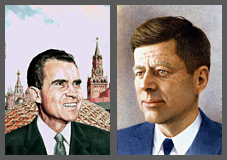50th Anniversary of the John F. Kennedy and Richard M. Nixon Debates, part 1

Right: John Fitzgerald Kennedy, 1917-1963 / Robert Vickrey, (born 1926) / Egg tempera on board, c. 1959 / National Portrait Gallery, Smithsonian Institution; gift of Wendy Carolyn Vickrey
Many pundits and critics commented that Vice President Richard Nixon looked terrible during the first televised presidential debates, especially because he was sharing the stage with his youthful and handsome opponent, John F. Kennedy.
Kennedy advisor and biographer Theodore Sorenson writes of the first debate, held on September 26, 1960, “Between the bleak gray walls and the bright floodlights of the television studio, [vice President Nixon’s] gray suit and heavily powdered jowls looked flabby and pallid beside Kennedy’s dark suit and healthy tan.”
The Nixon camp had attempted to impress upon America that Kennedy was too young and inexperienced to be the chief executive: Nixon, though only a few years older than Kennedy, had served as vice president for eight years under Dwight Eisenhower. Interestingly, when Nixon took the oath of office for the vice presidency in 1953 at age forty, he was the second-youngest man ever to hold the office—the youngest was John C. Breckinridge, who served under James Buchanan. However, neither youth nor experience seemed to matter on the night of that first debate. Another Kennedy biographer, Robert Dallek, writes:
Not yet fully recovered from a recent hospitalization to care for an infected knee injured in an accident, and exhausted by intense campaigning, Nixon appeared scrawny and listless. Ironically, Kennedy, whose medical problems greatly exceeded anything Nixon had, appeared to be the picture of robust good health. Kennedy further seized the advantage during the debate when he looked bored or amused as Nixon spoke, as if he were thinking, “How silly.”
At the end of the debate, as they stood on stage exchanging pleasantries, Nixon, watching photographers out of the corner of his eye, “put a stern expression on his face and started jabbing his finger into my chest, so he would look as if he were laying down the law to me about foreign policy or Communism,” Kennedy said. Again, the image was not one of command but of a schoolyard bully.
Before 1960, candidates could bombard voters with radio, television in its early years, newspapers, newsreels, periodicals, and live events. However, the 1960 election would be conducted in the light of a new American affluence. Millions of households owned radios, certainly, but millions also owned televisions, and those audiences were going to witness the Nixon-Kennedy verbal sparring with their own eyes from their own living rooms. This first of four debates was televised from Chicago and was broadcast nationwide on all television and radio stations.
On Friday, September 24, the second part of this article will discuss whether Nixon’s poor appearance on September 26, 1960—fifty years ago this week—actually cost him the election, as has been observed from time to time.
--Warren Perry, Catalog of American Portraits, National Portrait Gallery
Sources:
Robert Dallek, An Unfinished Life: John F. Kennedy (New York: Little Brown, 2003).
Theodore Sorensen, Kennedy (New York: Harper & Row, 1965).